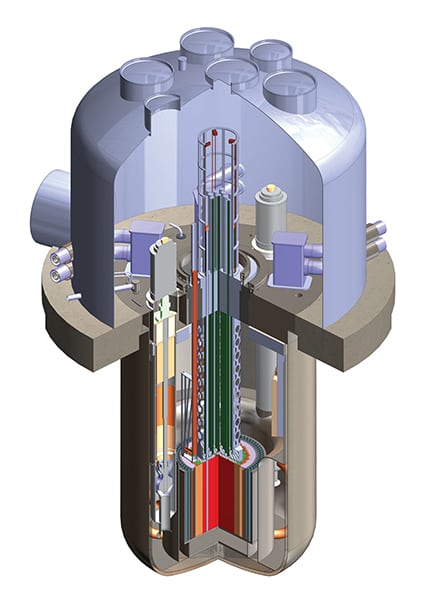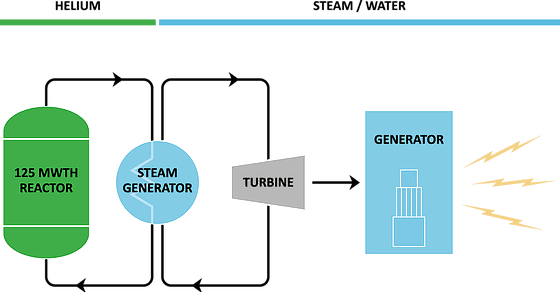Advanced Nuclear, Solar-Storage Projects Get DOE Funds
The Department of Energy (DOE) announced on January 15 that it was awarding up to $40 million each in cost-shared funding to Southern Co. and X-Energy to “support work to address key technical challenges to the design, construction, and operation of next generation nuclear reactors.” It also announced on January 18 that it was awarding $18 million to six projects that will develop combined solar photovoltaic (PV) and energy storage systems.
Advanced Nuclear Development
The nuclear-targeted funds were awarded under the Gateway for Accelerated Innovation in Nuclear (GAIN) initiative announced by President Obama November 6 at the White House Summit on Nuclear Energy. The administration said GAIN is intended to accelerate the commercialization of advanced nuclear reactor systems through expanded access to technical, regulatory, and financial support. In addition to funding, GAIN aims to reduce regulatory challenges and promote better sharing of information and research.
“In order to ensure that nuclear energy remains a key source for US electricity generation well into the future, it is critically important that we invest in these technologies today,” said Energy Secretary Ernest Moniz in a statement announcing the awards. “Public-private partnerships to develop advanced nuclear capabilities will enable low-carbon nuclear energy to power America for years to come.”
Fast Neutrons, Molten Salts
Southern Co. subsidiary Southern Company Services is partnering with Bellevue, Wash.–based TerraPower, the Electric Power Research Institute (EPRI), Vanderbilt University, and Oak Ridge National Laboratory (ORNL) to support development of a molten-salt fast reactor design called the Molten Chloride Fast Reactor (MCFR). The funds will be used to perform integrated effects tests and materials suitability studies.
Designs for fast-neutron reactors using molten salts have been around for decades, but success has been elusive. Proponents say such reactors could ultimately be simpler, safer, less expensive, and more flexible than existing designs, but the engineering challenges have been large.
A prototype molten-salt reactor using thermal neutrons operated at ORNL for several years before the program was shut down in 1969. TerraPower, co-founded in 2008 by former Microsoft Chairman Bill Gates, has spent years researching various advanced liquid sodium and molten-salt designs (Figure 1 ), and in September 2015, it also signed a memorandum of understanding with China National Nuclear Corp. to help commercialize its work.
- TerraPower has been working on several advanced nuclear reactor designs. Courtesy: TerraPower
The DOE announcement calls the MCFR “a next generation design with the most advanced safety features that enable its potential use across the country.”
Helium-Cooled Pebbles
Greenbelt, Md.–based X-Energy, meanwhile, is partnering with BWX Technology, Oregon State University, Teledyne-Brown Engineering, SGL Group, Idaho National Laboratory, and ORNL to “solve design and fuel development challenges” for its Xe-100 Pebble Bed advanced nuclear reactor concept.
The Xe-100 is a small high-temperature gas-cooled (HTGC) pebble-bed design. Each Xe-100 will generate 125 MWt and 50 MWe (Figure 2). As described on the company’s web site, four Xe-100 reactors would operate together as a 200-MWe unit. This, the DOE said, “would potentially enable such a reactor to serve a wider array of communities—particularly densely populated areas.”
2. The Xe-100 is a small, helium-cooled pebble-bed reactor that is designed to be used in four-unit plants close to demand centers. Courtesy: X-Energy
As with molten-salt designs, the HTGC approach has seen successes and failures, though HTGC has the advantage of having reached grid-scale generation with plants such as Fort St. Vrain in Colorado, which ran from 1967 to 1988.
HTGC reactors can potentially produce much higher-temperature steam than conventional light-water designs—making them more efficient—and the pebble-bed approach, which seals the fuel inside small ceramic spheres, is said to be incapable of meltdown. Several small test HTGC pebble-bed reactors have been built in Japan and China, with the latter project being developed into a 200-MW plant that is currently under construction with operation planned for 2017.
X-Energy said the funding will focus on “targeted technology development, including core modeling, fuel fabrication, and Nuclear Regulatory Commission outreach.”
Solar Storage
The six PV-storage awards were made as part of the DOE’s Grid Modernization Initiative announced January 14, and its ongoing SunShot Initiative to improve the economics of solar energy. The DOE said the projects would utilize internet-capable inverters and allow “smart” homes and buildings to work together with utility communication and control systems. Each project is either led by a utility or has a utility as a key partner.
The synergy between solar PV and energy storage has drawn increasing attention in recent years, but so far costs remain above competing technologies. According to DOE Assistant Secretary for Energy Efficiency and Renewable Energy David Danielson, one aim of the DOE’s grants is to improve the economics of combined solar PV and storage, and make the approach cost-competitive without subsidies.
“These projects will systematically address the challenges solar energy creates for the grid,” Danielson said during the media call announcing the awards. “Such solutions will help solar generation achieve much higher penetration levels than are currently possible.”
The six projects are:
- Austin Energy will receive $4.3 million to create a distributed energy resource management platform that is adaptable to any region and market structure, aiming to establish a template that can help to maximize the penetration of distributed solar PV.
- Carnegie Mellon University will receive $1 million to develop and demonstrate a distributed, agent-based control system to integrate smart inverters, energy storage, and commercial off-the-shelf home automation controllers and smart thermostats.
- Commonwealth Edison will receive $4 million to utilize smart inverters for solar PV and battery storage systems, working with other components within a microgrid community.
- EPRI will receive $3.1 million to work with five utilities to design, develop, and demonstrate technology for end-to-end grid integration of energy storage and load management with PV generation.
- Fraunhofer USA will receive $3.5 million to develop and demonstrate a scalable, integrated PV, storage, and facility load-management solution through the SunDial Global Scheduler system.
- The Hawaiian Electric Co. will receive $2.4 million to show the system-level benefits of enhanced utility visibility and control of the distribution system by enabling the proliferation of distributed renewable energy technologies.
—Thomas W. Overton, JD is a POWER associate editor (@thomas_overton, @POWERmagazine).

